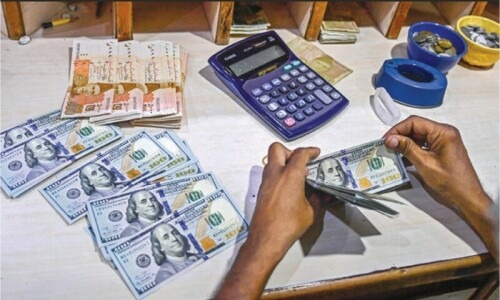KARACHI: According to market insiders, speculative forces were able to take advantage of the vacuum created by the US dollar’s upward movement against the rupee at the beginning of March.
The State Bank of Pakistan (SBP) reports that on Tuesday, the interbank market saw a five-paisa increase in the value of the dollar to Rs279.31. Banks asserted that the dollar price was more than what the SBP had stated.
The rupee has depreciated against the US dollar during the past three working days, rising from Rs279.11 on February 29 to Rs279.31 on March 5.
According to market sources, the International Monetary Fund (IMF) would put a lot of pressure on the recently elected Islamabad government to reduce imports.
According to media sources, the IMF wants to see a 50% increase in imports in the months that remain till the conclusion of FY24. Growing imports are taking dollars out of the market while the SBP is attempting to hang on to them tightly. Although the SBP has been successful in keeping the exchange rate steady thus far, the growing demand for dollars may cause problems for this management.
Concurrently, it is anticipated that the government would quickly start negotiations with the IMF for a fresh $6 billion loan. According to market analysts, the new government may only have a few weeks to apply for a new loan from the IMF because final approval for the necessary cash requires completing paperwork and satisfying donor agency conditions.
Government under pressure as the IMF wants imports to increase by 50% for FY24; $6 billion shortfall exists notwithstanding rollovers from China and the UAE.
Currency traders forecast that March will see further market volatility as a result of growing uncertainty surrounding fresh loans, IMF requirements, and the SBP’s ambiguous reserve position. At the end of this month or early in April, the central bank is anticipated to receive $1.2 billion from the IMF as the final installment of the $3 billion Stand-By Arrangement.
Nevertheless, even with China and the UAE rolling over their loans, the government will not have enough money to service its debt in FY24—at least $6 billion shortfall.
There is also management of the open market dollar rates. The majority of currency traders only give their clients dollars for travel. The market worries that increased demand for dollars as a result of increased imports may lead to a shortfall and upset the steady exchange rate that is currently in place.
The necessity for a balance between inflows and outflows is emphasized by market sources, who stated that the current state of affairs is favorable for speculators and black markets. However, it looks as though outflows will be significantly larger throughout the remainder of FY24.








